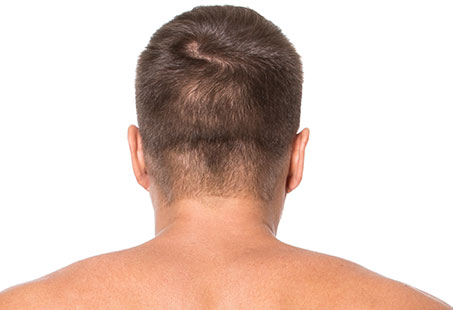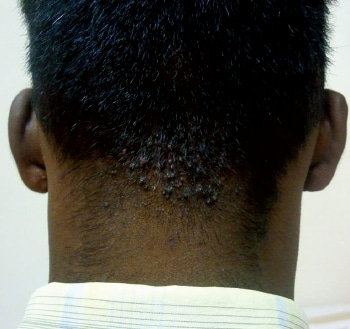Hair loss is often seen and noticed on the scalp top and front, but it can also affect the back – specifically the nape of the neck.
It is possible for hair loss to only occur at the nape of the neck; however, it can also occur in other areas simultaneously.
In any case, it’s important to understand why it’s happening, so you can seek early treatment. That can help slow down or even halt the progression of hair loss at the nape of the neck.
What Causes Hair Loss At The Nape Of The Neck?
Hair loss at the nape of the neck can occur due to genetics, stress, tight hairstyles, skin conditions, autoimmune diseases, inherited disorders and syndromes.
Let’s take a closer look at each of them.
Genetics
Classic male androgenetic alopecia is characterised by miniaturisation and hair loss at the front, top and vertex of the scalp. So, the hair at the back and sides is spared (which can then be used for hair transplant).
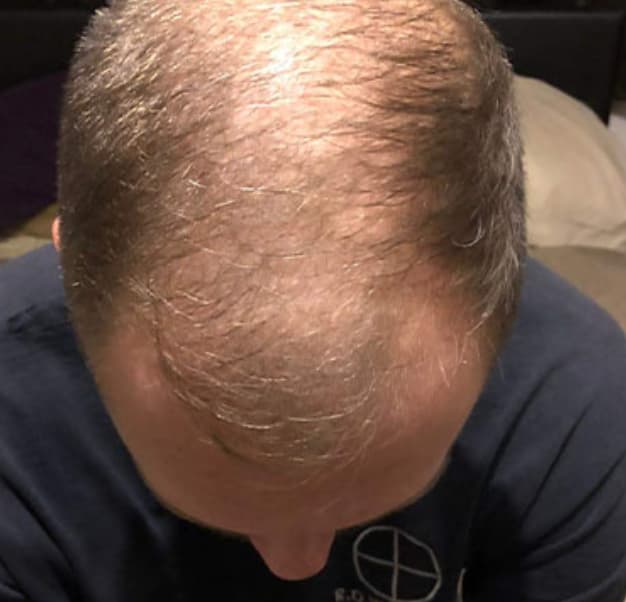
There is, however, a type of androgenetic alopecia that begins at the nape of the neck and progresses upward. It’s called retrograde androgenetic alopecia.
So, essentially, the pattern of hair loss is reversed. It moves from back to front instead of front to back. Although there have also been cases where both the front and the back were affected.
There’s also another pattern of hair loss that affects the nape of the neck and the rest of the scalp. It’s called diffuse alopecia.
In both these cases, there’s no stable “safe” zone at the back of the head for harvesting and transplanting grafts. In such an event, patients are advised alternative non-surgical treatments.
Stress
Stress is another factor that can lead to hair loss at the nape of the neck. For one, it can cause telogen effluvium, which can cause diffuse thinning all over the scalp.
Moreover, stress can also cause hair thinning at the nape of the neck due to the hair-pulling disorder trichotillomania. The urge to pull the hair out can leave bald patches there.
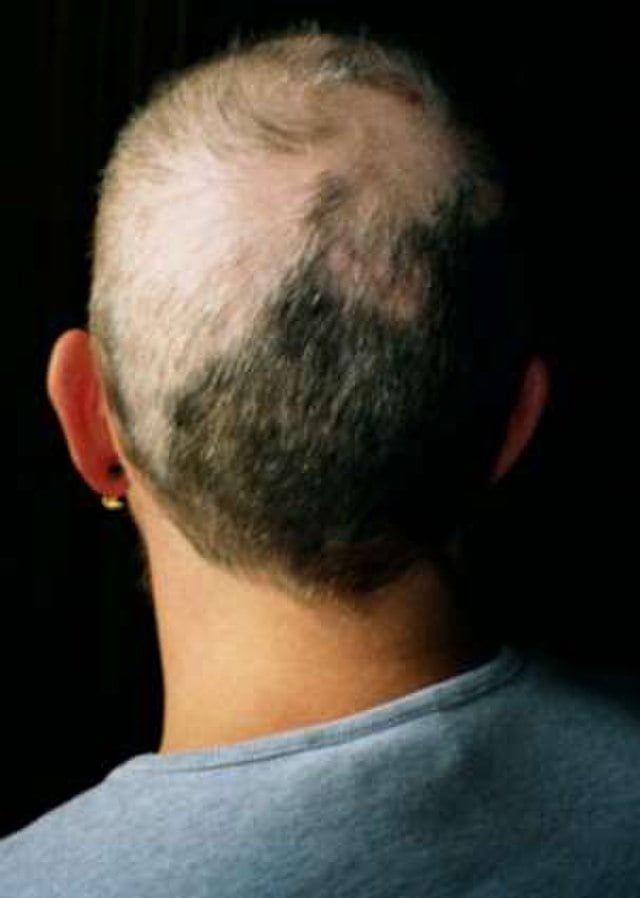
Traction Alopecia
Tight hairstyles not only affect the hairline and the temples but also the back of the head.
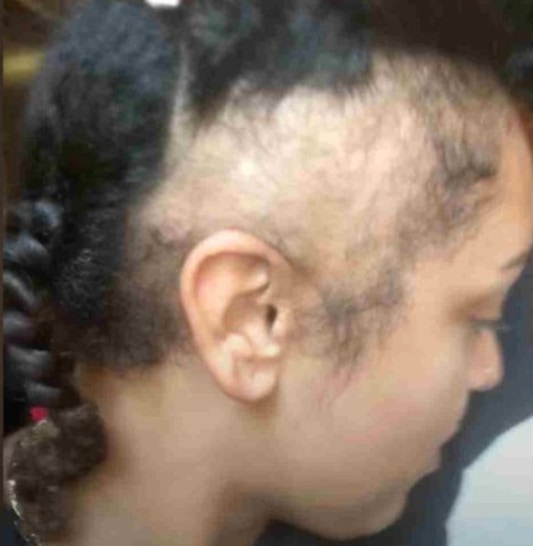
For instance, when you make a high and tight ponytail, all the gathered hair will be under tension. And making these tight hairstyles for a long time can result in permanent mechanical damage.
As a result, you may experience neck hair recession.
Alopecia Areata
Alopecia areata is an autoimmune condition that attacks healthy hair follicles, causing hair loss. There are different types of it which affect the scalp and/or the body.
Ophiasis is a form of alopecia areata that causes hair loss at the back of the ears and at the nape of the neck in the form of a symmetric band.
According to the National Alopecia Areata Foundation, this type of alopecia areata doesn’t respond to medications as quickly. Therefore, it can be more difficult to treat.
Other than that, alopecia totalis, universalis and diffuse alopecia areata can also cause thinning or balding of the nape area.
Lupus
Lupus is another autoimmune disease that affects the healthy tissues in the body (including the hair follicles).
As far as hair loss in the nape area is concerned, discoid lupus erythematosus can result in the formation of scaly plaques in the area. That can result in inflammation and scarring, causing permanent lupus hair loss.
Systemic lupus erythematosus (SLE), which is the most common type of lupus, can also cause non-scarring diffuse alopecia. Of course, that can also cause hair loss at the nape of the neck.
Acne Keloidalis Nuchae
Acne keloidalis nuchae, also known as folliculitis keloidalis, is a chronic skin disorder affecting the nape area and the back of the head.
It results in the formation of keloidal plaques and papules, which can result in scarring and permanent hair loss at the nape of the neck.
This condition affects more men than women (especially those with curly hair). So, it’s believed that androgens are somehow involved in the inflammation of the hair follicles.
Psoriasis
Psoriasis is another autoimmune skin condition that can affect the skin of the scalp at the front and back.
Because of this condition, thick, crusted patches form on the skin, which can cause a lot of itchiness. It’s that scratching (and picking at the crusts) that actually causes hair loss.
Cephalgia Alopecia
Cephaglia refers to pain in the head.
Cephalgia alopecia is when a “stabbing, burning” pain in the head and neck leads to hair loss in the areas affected by the pain.
Research published in Current Pain and Headache Reports states that it occurs due to “neuroregulation of skin and nerve.” Repeated innervation of hair follicles affects their structure in a way that negatively impacts hair growth.
Monilethrix
Monilethrix is an inherited disorder that affects the structure of the hair shaft, making it weak, dry, and prone to breakage.
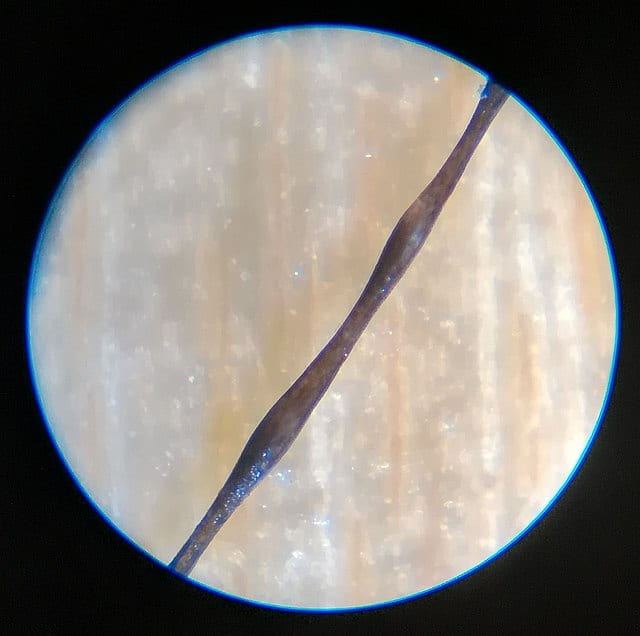
According to the US National Library of Medicine, in its mild form, it only affects the nape area. However, when it’s more severe, it can cause hair loss across the scalp and other areas of the body.
Nevus Sebaceous Syndrome
Nevus sebaceous is a rare inherited disease that results in the formation of lesions in the sebaceous glands. Most commonly, these lesions form on the scalp. But they can also develop on the face and neck.
With age, these lesions become more prominent and thick and scaly. And they can also cause complete or partial hair loss.
Is Hair Loss At The Nape of The Neck Reversible?
If you’ve lost your hair in the nape area, it can only grow back if the hair loss is reversible. This can happen, for instance, if the hair loss is due to stress, telogen effluvium, alopecia areata, psoriasis or tight hairstyles.
Even though these alopecias are reversible, you might need some sort of treatment to grow your hair back. For example, for alopecia areata, you may need steroid injections.
On the other hand, if you have androgenetic alopecia or the skin in the nape area is scarred, or the follicle is damaged, the hair loss might be permanent. This can happen if you have acne keloidalis nuchae, discoid lupus, etc.
How Can You Stop Hair Loss On The Back Of Your Head?
In order to stop hair loss at the back of the head, you must take into account the type of hair loss you are experiencing.
Many treatments are available to slow down or reverse different types of hair loss affecting the nape and other scalp areas. These include:
- Minoxidil
- Finasteride
- Dutasteride
- Laser hair growth therapy
- Platelet-rich plasma injections
- Steroid injections
- Botox
You can also consider hiding the bald patches in your nape area by wearing wigs, trying hair fibres or wearing neck scarves/mufflers.
For permanent, natural-looking results, you can also get an affordable hair transplant in Istanbul (if you have sufficient donor area hair).
A study published in the Journal of Cosmetics, Dermatological Sciences and Applications reports successful transplantation of hair follicles in patients who’d lost hair in the nape area.
Other than that, you should also make sure to have a healthy diet as nutritional deficiencies can also cause hair loss. It’s also a good idea to be gentle on your hair and avoid excessive styling.
Conclusion
There are different types of hair loss that can affect the nape area of the neck specifically and the entire scalp and/or body in general.
Depending on the cause of hair loss, it may be possible for you to regrow your hair at the back of the head. However, you shouldn’t start any treatment on your own.
It’s important to get an accurate diagnosis first, and for that, always consult a medical professional. They’ll also create a treatment plan for you.
